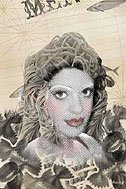"When are we going to make that pasta again, Ms. G.?"
"Yeah! Are we? When? Pleeeaase!"
I've been trying to ignore the pitiful looks and all-out begging from my 7th-grade Open Doors students (most of whom I taught last year as 6th-graders) all school year. I thought that eventually they would forget about it, but the pleas started up again last week.
They want to make pasta puttanesca. I have been more than a little surprised by their repeated requests. I eat lunch with these people everyday; I have watched them make vampire teeth out of their pizza, put mayonnaise on their hot Cheetos, and eat their spaghetti with mustard and ranch dressing.
Should I be surprised that they want to eat something that contains anchovies and capers?
For the past two years, my classes have made pasta puttanesca in connection with Lemony Snicket's "The Bad Beginning." I know it's not high-quality literature, but it's fun, and it provides great fodder for research. The characters in the novel actually make the pasta dish, so cooking it made a perfect real-world link with what we had read in class.
I can only imagine what their parents thought when I asked them to send garlic and black olives to school.
State regulations require gifted education classes to be small, which meant all of the students got involved in cooking. We set up a hot plate on the lab table in our classroom and got to work.
While I stood on a chair to oversee and keep the entire operation under my supervision, the students were fine, sautéing the garlic and stirring in the tomatoes. They even handled the capers well, even though most of them agreed that the pickled flower buds weren't particularly tasty. The problem came when it was time for the anchovies.
One brave student opened those smelly, salty little fishes and incorporated them into the already simmering sauce. The words of a former student came to mind "Boy howdy, did it smell!" Actually, anchovies don't just smell—they reek.
I worked in a pizza place one summer, and I can still attest to the fact that the smell from one anchovy pizza would linger in the air for the rest of the day. And the anchovies in our class weren't mere toppings—they were cooked, heated, made to smell even stronger than those at the pizza joint.
As the aroma of the puttanesca sauce wafted down the hall, numerous teachers wandered into our classroom to investigate the source of the aroma. Only a few were willing to taste the pasta, while almost all of my students eagerly dove in. And much to their surprise, most of them actually liked it. None of thought they'd be begging for it again a year or two later, but they are. Go figure.
I first made pasta puttanesca for a dinner party in college. It wasn't the ingredients or the simplicity of its preparation that originally attracted me to the recipe. It was the history of the dish—pasta puttanesca originated in Italian brothels, a fact that I most assuredly did not share with my students. Later I made it because it is a cheap way to feed a bunch of people. Now I make it because it is quick. You can put a whole pot together in under 20 minutes. Pasta puttanesca seems to have universal appeal on a variety of levels. Even to teenagers.
It is a dish that, according to another student, "is good but has some nasty stuff in it." I agree with him completely. It has a spicy, complex flavor. The capers, anchovies, and olives give the sauce a rich and salty essence. Somehow, the "nasty stuff" works together to develop the savory end result.
When cooking the pasta sauce, how much you add of each ingredient is really up to you. Sauté minced garlic in olive oil. Add one to two regular-sized cans or one large can of diced tomatoes and a handful of pitted black olives (preferably Kalamatas), sliced. Toss in a pinch or two of red pepper flakes. Add at least a tablespoon of capers and one can of anchovies (packed in oil). Let this simmer for a few minutes and then taste. It should be pretty salty and a little tangy by now. If it's not, add a few more capers. Finally, toss in a handful of chopped parsley. Let simmer for about five minutes or until you are ready to eat. Serve over pasta.
As for making pasta puttanesca again this year, I still haven't decided yet. I think I'll try to find a new "nasty" recipe instead.



Comments
Use the comment form below to begin a discussion about this content.